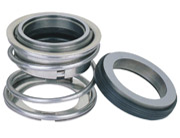Currently, mechanical seal failures are the #1 cause of pump downtime. Mechanical seals are at the forefront of functional industrial pumping systems with the goal of restraining product leakage. However, mechanical seals are often made from a list of very delicate components that lead to failure if standard protocol & maintenance is not implemented.
 3 Ways to Prevent Mechanical Seal Failure
3 Ways to Prevent Mechanical Seal Failure
1. Proper Installation
Installation for any mechanical seal should strictly follow the guidelines and instructions set forth by the manufacturer. All seals should ne handled with extreme care to prevent damaging the seal faces or O-rings.
Here are some common issues we’ve seen occur in the installation process:
• Not tightening the set screws before removing the setting clips
• Not tightening gland bolts evenly
• Damaging O-rings or seal faces from lack of care
• Lack of knowledge or understanding resulting in improper installation
2. Preventing Excess Heat Generation
Excessive heat generation will dramatically affect a seal’s life span, with dry running being one of the most common culprits. Preventing these instances from occurring will keep you from unwanted repairs or costly mistakes. Here are a couple scenarios to consider.
• If the seal chamber’s pressure exceeds the seal’s design parameters, then you should contact the seal manufacturer for more guidance, as the seal may need to be altered.
• If the process fluid in unable to properly lubricate the seal faces, then you need to re-consider the sealing solution based on application and system details.
Reliable seal performance is often achieved when the correct piping system is used, proper pump preparation is carried out, and pump functions fall within the OEM (original equipment manufacturer) parameters.
3. Mechanical Seals Must Be Stored Properly
Because mechanical seals contain a mix of metallic and non-metallic materials, they are very delicate by nature and must be properly stored in order to prevent unnecessary damage or failure. Refer to our basic guidelines below when storing a mechanical seal.
When storing a mechanical seal for more than 2 years:
Disassemble the entire seal and store them as individual components. O-rings should adhere to the environmental conditions below. If the seal has been in use, then all parts should be cleaned and dried before storage. All openings in the seal’s gland should be plugged & seal faces should not be stored together in the same packaging.
When storing new seals for less than 2 years:
No disassembly is required, but the seal should be stored in a clean, cool environment. Please refer to our environmental conditions guidelines below. Also, the seal’s faces must be rotated against each by two turns every 3 months if it is not currently used in operation in order to prevent face lock and loss of face flatness.
Environmental Conditions for all Mechanical Seals
For any mechanical seal, there are environmental conditions that should be adhered to at all times.
• Room temperature must remain between 40 F & 80 F with humidity less than 70 percent.
• No exposure to radiation or sunlight.
• No exposure to contamination from solvents, oils, copper, or pumped products.
• No exposure to ozone or ozone-generating devices or equipment.
Pump Engineering Company offers industrial pump repair & services to several counties located throughout Southern California & Northern California. Contact us toll-free @ 800.560.7867 for more information regarding our services.
